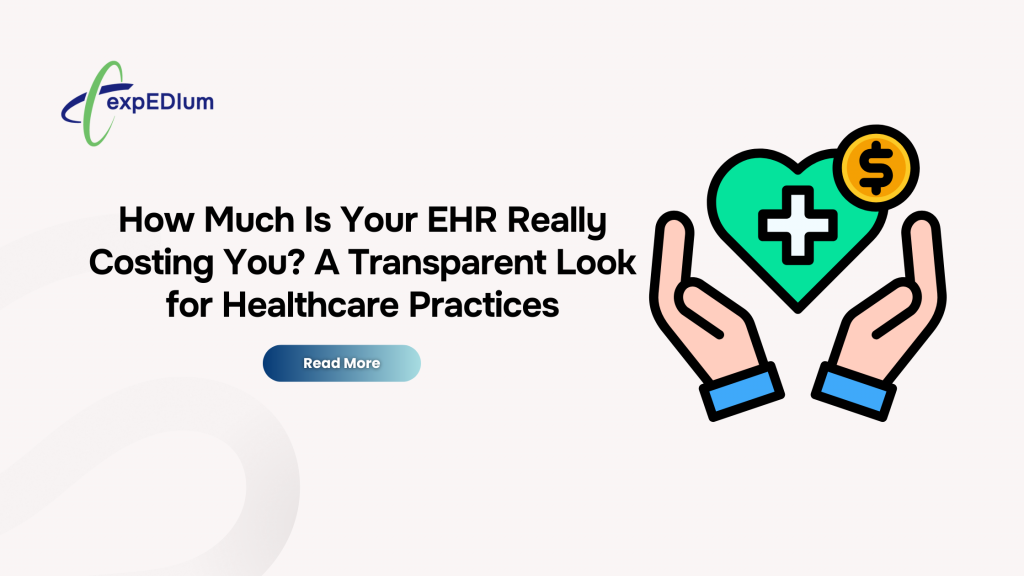When evaluating electronic health record (EHR) systems, most practices focus on upfront pricing. The number looks manageable, maybe even competitive. But beneath that surface lies a complex web of hidden costs—in lost productivity, training time, data migration, and inefficiency.
If you’ve ever wondered why your revenue doesn’t match your patient volume, your EHR could be part of the answer.
The Hidden Price of Complexity
A recent survey found that over 60% of physicians report that their EHR systems increase clerical burden rather than reduce it. What looks like a digital upgrade can often become an obstacle—when workflows are clunky, support is limited, and customization costs pile up.
Hidden EHR expenses typically come from:
- Inefficient workflows that increase time spent on documentation.
- Paid add-ons for necessary features like e-prescribing or analytics.
- Staff training costs every time the system updates.
- Downtime during upgrades or server issues.
- Revenue leakage due to claim errors or delayed billing.
The result? Practices spend more hours on maintenance than on patient engagement, defeating the very purpose of EHR adoption.
The Real Cost of “Free” or Low-Cost Systems
Some systems lure smaller practices with minimal upfront fees—but revenue loss starts later. When key modules (like billing or patient portals) come with additional costs, the total expense can double within a year.
Moreover, limited scalability means that as your practice grows, you’re forced into a migration—a process that can disrupt operations and cost thousands.
When Time Becomes the Most Expensive Currency
EHR inefficiency isn’t just a budget problem; it’s a time problem. Every minute your staff spends navigating extra clicks or reconciling duplicate entries is time lost from patient care.
Multiply that across a week, and you’ll find hours that could have been used for follow-ups, new patient onboarding, or revenue analysis.
A well-structured EHR cost analysis should factor in these hidden productivity losses, not just subscription or licensing fees.
The Case for Transparent, Scalable EHR Solutions
A truly cost-effective EHR is one that grows with you—not one that surprises you with hidden charges. Cloud-based systems that integrate billing, scheduling, and reporting eliminate the need for multiple tools or redundant data entry.
For instance, expEDIum Office EHR was designed to simplify cost control through:
- Unified system architecture – no need for separate billing or analytics software.
- Transparent pricing – no hidden maintenance fees or upgrade charges.
- Custom configuration – so you pay for what you use, not for bundled features you don’t need.
- Interoperability – easy data sharing across clearinghouses and billing systems without extra integration fees.
Avoiding Costly Transition Mistakes
Switching from one EHR to another can feel daunting, but the longer you delay, the more hidden costs accumulate. A thoughtful transition plan should include:
- Data migration support that minimizes downtime.
- Training that’s role-specific to shorten the learning curve.
- Post-launch monitoring to ensure workflows are stable.
expEDIum’s team offers guided implementation that ensures cost savings from day one—not months later.
Measuring the ROI of Simplicity
The best EHRs demonstrate their value in time saved, claims paid faster, and fewer errors—not flashy dashboards. Practices that track these improvements often find that operational simplicity yields measurable ROI.
When clinicians spend less time on system navigation and more on patient interaction, both satisfaction and reimbursements improve.
A Transparent Approach with expEDIum
At expEDIum, we believe EHR solutions should deliver clarity—not complexity. Our approach focuses on transparent pricing, cost-efficient scalability, and seamless integration with billing workflows.
By helping practices eliminate redundant costs, reduce administrative strain, and improve claim turnaround, expEDIum ensures that your EHR becomes a tool for growth, not a hidden expense.
When it comes to EHR systems, the question isn’t just “What does it cost?”—it’s “What is it costing you not to optimize?”
Explore expEDIum Office EHR to uncover a transparent, scalable, and cost-efficient solution built to simplify practice management.
Suvarnna Babu is a B2B content marketer and Digital Marketer at expEDIum, where she specializes in writing healthcare tech blogs that simplify complex RCM and EHR concepts for providers and billing professionals. With a background in English Literature and hands-on experience in SEO, email marketing, and paid ads, she creates content strategies that align with business goals and resonate with real-world users.
